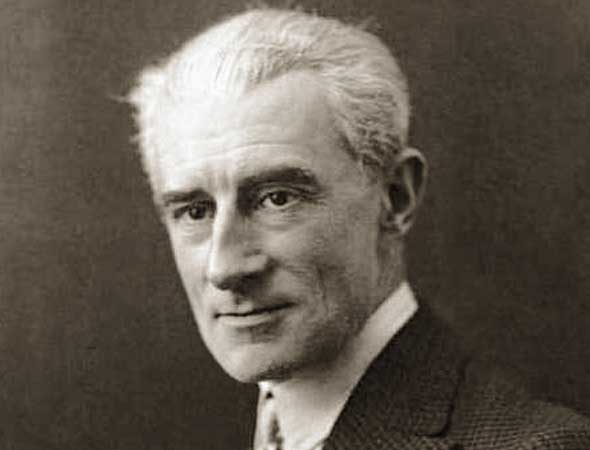RAVEL: Daphnis et Chloé, Suite No. 2
Instrumentation: 4 flutes, 3 oboes, 4 clarinets, 4 bassoons; 4 horns, 4 trumpets, 3 trombones, tuba; strings; percussion; adult mixed chorus (soprano-alto-tenor-bass).
Friends and family are often indispensable resources for the program annotator. When this author mentioned to a longtime concertgoer that he was writing a note on Ravel’s Daphnis et Chloé, she said “I find that music quite erotic.” She’s not the only one. With its huge orchestra and wordless chorus, this remarkable work — the largest-scaled that Ravel ever composed — captures the classical union of physical and spiritual love with vivid immediacy. Ravel worked on it for three years, completing it in April of 1912. It is one of the greatest ballet scores of the 20th century, and is considered by many to be Ravel’s greatest masterpiece.
Choreographer Michel Fokine created the scenario for the ballet based on a pastoral drama by the Greek poet Longus depicting the story of Daphnis and Chloé’s courtship and Chloe’s abduction and escape from a band of pirates. This exotic scenario, teeming with incident and passion, calls for music of color and intensity — a perfect opportunity for Ravel to explore the limits of musical Impressionism’s scintillating expressiveness.

Maurice Ravel
The commission for Daphnis and Chloé came to Ravel in 1909 from Serge Diaghilev, impresario of the Ballets Russes. This legendary troupe was a virtual hothouse of creative talent, attracting the greatest composers and artists of the day. The ballet’s myth-based plotline, though unfamiliar here, was well known in France since Renaissance times. It combines elements of a pastoral romance, a heroic adventure and a fairy tale. The action takes place on the legendary Greek isle of Lesbos in a sylvan grove sacred to the god Pan and depicts how childhood companionship flares into passionate romance between two foundlings, Daphnis and Chloé, raised by shepherds.
As friendship blooms between them, Daphnis teaches Chloé to play the pan-pipes and they instruct each other in life. Their naïve but increasingly passionate relationship foreshadows modern romances such as The Blue Lagoon: They don’t realize they are falling in love, though it is obvious to us as we watch (or listen). When Chloé is abducted by pirates, Daphnis prays to the god Pan, who could be described as the patron saint of rustics, for aid. And aid them he does: the transcendent, ethereal chorus that is a signature sound of this ballet score depicts the god Pan’s entry into the pirates’ camp. His very presence overwhelms the pirates with fear of his power — the word “panic” is derived from “Pan” — and Chloé’s escape is effected in time for the ballet to close in triumph.
There is a sense of ancient and mythic breadth in the scope of Daphnis et Chloé, as in a great tapestry; Ravel described its music as “a choreographic symphony in three parts…a vast musical fresco, less scrupulous as to archaism than faithful to the Greece of my dreams…” The music’s extraordinary quality and expressive power are immediately apparent to us and must surely have been apparent to contemporary audiences, though its peculiar performance history does not reflect this; its premiere performance at the Théâtre du Châtelet in Paris received only a tepid response. (Just a few days earlier, the dancer Vaslav Nijinksy’s erotically explicit performance in l’Après-midi d’un faune, also entailing the god Pan and sexual naïvete in the woods, had caused an uproar.) The full ballet is rarely performed today, in part because of the difficulty of assembling the full resources needed to perform it. But Ravel derived two suites from it, and these, along with the full score, have entered the standard concert repertory.
We can hear the richness of Ravel’s huge tapestry in the Suite No. 2 he extracted from the full ballet. It opens with a highly pictorial rendition of sunrise over the sylvan landscape where the two lovers are reunited, orchestrated with Ravel’s inimitable deftness, and culminating in a dance of joyous celebration. Throughout the music we experience a sense of magic — an elusive sense that we have entered the world of our dreams, a sensual realm that extends into the furthest reaches of our imagination. Ravel achieves this in part through musical values that are beautiful and ambiguous in equal measure: strange, unfamiliar rhythms that never seem to settle down and resolve themselves; startling instrumental entrances; luminous textures and shimmering harmonies that, again, never seem to reach a clear resolution; and “stacked” intervals of interlocking fourths and fifths. But that accounts for only part of the ballet’s supernatural effect. The rest is sheer genius.











